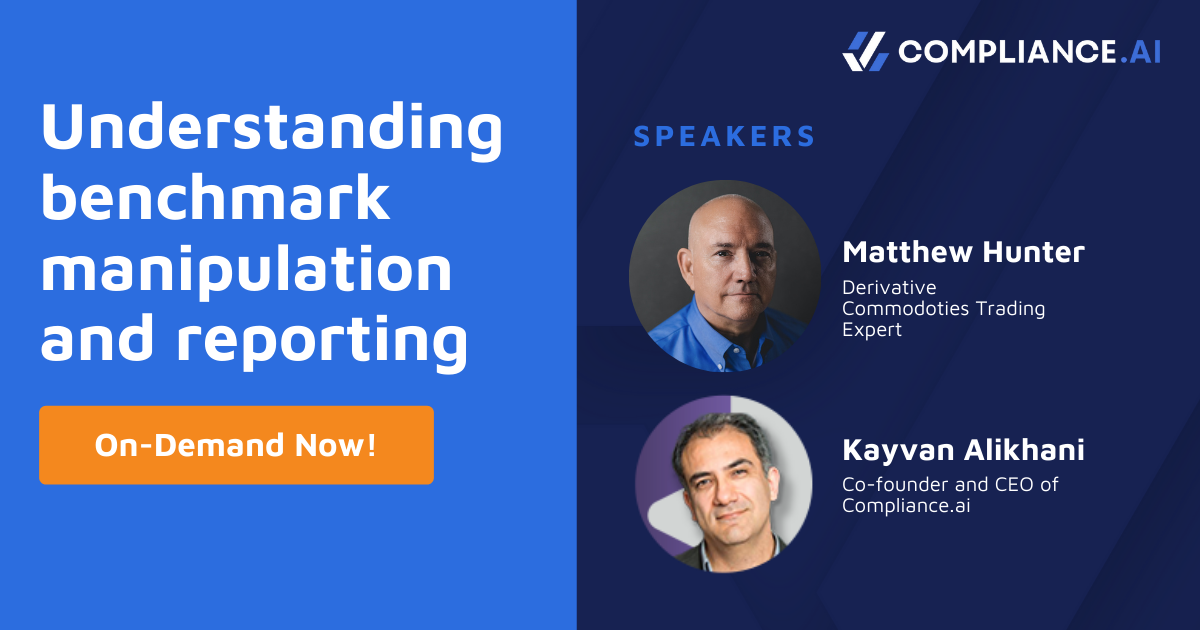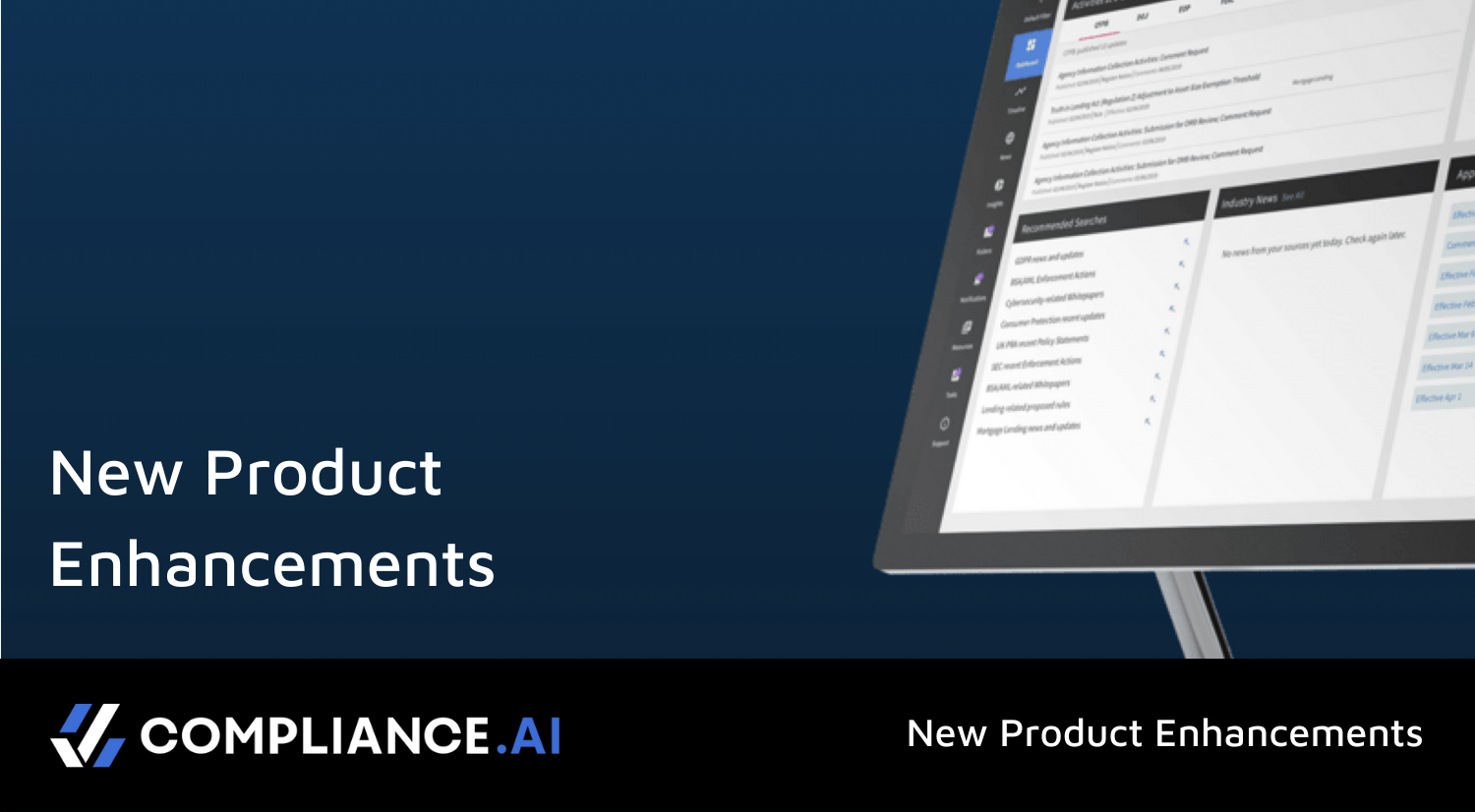In September, Compliance CEO, Kayvan Alikhani, got together with commodities expert, Matthew Hunter, to discuss Benchmark manipulation and reporting. In this webinar they discussed the economics of the perception of compliance vs compliance including:
– Are you manipulating your benchmarks?
– When you are non-compliant in a major market what do you do?
– Is it cheaper to pay the fine than to put the compliance program in?
– A discussion on the perception vs reality of compliance.
Click the video to watch it on-demand now. Transcript below.
Financial benchmarks play a fundamental role in valuing millions of financial instruments and amounts of payments under many financial contracts such as commodities, interest rates, student loans, personal loans and mortgages.
During a recent webinar, Compliance.ai CEO Kayvan Alikhani discussed the manipulation of financial benchmarks and related conduct issues in financial services with Kayvan Alikhani, CEO and co-founder of Complience.ai and Matthew Hunter. They also explored how organizations’ risk and compliance functions are responding to the wide-ranging challenges they are facing.
Understanding Benchmarks
Benchmark manipulation is happening everywhere in financial services, from every commodity and settlement of large swaps to futures contracts potential. However, it is difficult to detect at any given moment, can be seen readily by firms themselves and their own data — And generally, it’s not picked up by either compliance or risk in firms.
The basic motive for manipulating benchmarks is a desire to profit by introducing some element of their speculative interest into the fundamentals of supply and demand to enhance the value of a portfolio. Trading desks and individuals on trading desks colluding to share market-sensitive information is just one example.
What are the Risks?
Benchmark manipulation is the most significant violation that exists, not just the commodity world, but in other worlds as well. Whether it’s treasuries or securities to push a benchmark for a purpose, to change its value to enhance the enhanced portfolio is illegal everywhere – now even under fraud statute.
The CFTC is not the only agency tied to this. There are multiple other agencies, or regulatory enforcement, including the DOJ that are tracking this. They’re not the same as the legalities that the CFTC views which is derivative first, but also commodity and interstate commerce. Then you can look at their other rules on the books, you could be in violation of another nation. Now, the EU FCA England rules and regulations because so many markets are tied to push one thing in one place, it moves in another and particularly if it’s purposeful, that you’re changing the value of something to get at the value of something else.
Addressing the Challenges
Not everybody looks at benchmarks through the same lens. Many organizations have a contrary or different view about benchmark manipulation and whether they should spend money on developing a robust compliance program.
The majority of organizations, the senior management, wants compliance. And then as things go down the chain, it’s all about performance. The only way to ensure you are compliant with the rules and the regulations and the spirit with which they were written is to read the rules. Otherwise, you’re going to miss when the rules change, and rules change all the time.
Sometimes a significant number of years before there’s even a discussion about how the old rules interacted with the new rules, and then when somebody changes a rule, and whether that’s, you know, at the federal state or exchangeable governing body level.
Generally, compliance training is once a year, it’s a very broad stroke. If the initiatives underway by the regulator’s themselves to help provide some hints, advice, guidance around these types of I would call it ad hoc on demand training, or self-check activities. We’re seeing some more forward-looking regulators really moving in that direction.
What’s Next for Financial Services?
The process of discovery first is not simple. Whistleblower rules are helping dramatically and everyday someone is self-reporting some amount of violation. More than anything, there are discussions about if they find it, if someone determines that it happened –how to reduce it, to eliminate it, not go forward with it, but not necessarily report it.
To find someone who’s in violation, regulators can do audits. It’s very hard to just look at raw data when you only have portions of the data, not a full data suite to then say a person is involved in risky behavior.
There is a difference between both the approach and the level of enforcement within federal, state and international regulators. But each gets more balkanized. Every chairman has an agenda and works in an intimate way with their enforcement on and each enforcement arm therefore has an agenda and how they want to prioritize their resources, your resources in the federal government.
Enforcement actions, both on a transactional and an accordion level quarterly level as an ongoing concern. There is growing interest in this idea of looking at it from a type of violation level of enforcement jurisdictions and then of course trending, both specific to a regulator and across regulators within the jurisdiction. From one side, you’re looking at the cost of noncompliance from an enforcement action perspective, but then there’s also the reputational risk in the aspect of being in the news and for the wrong reasons. The immediacy of information distribution and the magnification of it, is also becoming more and more important to organizations.
At a basic level, the number one thing that should be happening is self-reporting, if someone catches their staff involved in a questionable activity.
Compliance Perception vs. Reality
The number one thing a company must have in their compliance strategy, to prevent benchmark manipulation is data. Benchmark manipulation gets interesting when it’s left to the survey — where it doesn’t cost any money to alter the perception. Generally, what happens is because it’s settling out, no one is looking at that day’s trading of something that’s disappearing, they only look at the dollars. Manipulation is much more subtle and much more difficult to prove when you’re talking about how the curve moves and whether the curve was manipulated on any given day.
Organizations should examine data and trends, being accepting of a changing portfolio alongside a longer-term strategy. Every company looks at their data differently. If a company is already looking at harmonized data, they can build internal automated programs to look at the company every single day.
RegTech / FinTech in the Future
Here are some options in terms of where to begin looking for that, the ability to be agile and move quickly looking for any and all opportunities.
The approaches today of continuously trying to turn Microsoft Excel into an operating system of having those operations that you’re talking about done manually causes out of date reporting in consistency in terms of the outcome, lack of scalability, and of course, added costs.
Many organizations don’t want to pay for compliance and a trade capture system. Those organizations that do are moving more swiftly. And the ones that don’t, look at it as an afterthought or a cost center, as opposed to instrumental in the product development lifecycle and the company’s development lifecycle, that it has to move at the same pace and be able to provide feedback at the same rate of pace to then prevent on basically wanted fines, penalties, and of course, costs that go along with trying to do this manually in the absence of technology.
In the future, RegTech / FinTech solutions will help organizations reduce noise, improve that level of automation and simplify both the creation of the reports and the transparency in terms of distribution and dissemination of that information.





